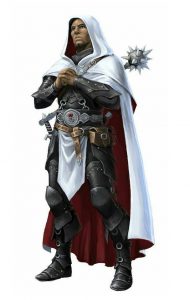From there Elisha went up to Bethel. As he was walking along the road, some young men came out of the town and mocked him. “Get out of here, baldy!” they said. He turned around, looked at them and called down a curse on them in the name of the Lord. Then two female bears came out of the woods and mauled forty-two of the young men.
– 2 Kings 2: 23-24
Wow, that’s an odd Bible passage, is it not? But it makes perfect sense to a D&D player, a point we’ll get to in a minute. But, first, a little context.
In the Old Testament scriptures, Elisha was one of God’s prophet’s, a messenger to the nation of Israel. His job was to plead with corrupt people, calling them to return to the worship of God and to turn away from idolatry or pagan practices.
Bethel was notable as a center for idolatrous worship in that area, being christened as such by King Jeroboam, who had instituted idolatrous worship as a political maneuver to keep his citizens from visiting Jerusalem. If you recall hearing about golden calves in Sunday school, you’re on the right track.
Eight kings and several dynasties later, Bethel had become a city thriving through the commerce of being a pagan worship/tourist center. And while there remained a remnant of God-fearing people in Bethel, a group of young hoodlums were not among them. So when those same young hoodlums mocked and teased Elisha, he called down God’s wrath upon them.

Yeah, still odd. But not to a D&D player. I read that passage and I see a neutral good cleric use a summon monster spell to take out a bunch of chaotic evil cultists. That’s really ho-hum D&D fare actually.
D&D is set in a moral universe, particularly in the early years, where alignment weighed more heavily and imaginary religious pantheons and characters were central to the game. Indeed, one of the first character classes in the game was a cleric, a hero whose power came from devotion to a deity.
But clerics didn’t appear often in fantasy literature previously, with the exception of Friar Tuck and a few others. Few fantasy author influences of D&D even had overtly religious heroes in their work. Yet, Gary Gygax and Dave Arneson had other ideas.
The cleric seemed to arrive through two primary influences, plus a little dollop of inspiration from the prevalence of Christianity in 1960s horror flicks like Dark Shadows and others.
- First, the prevalence of the Catholic Church in medieval European society wasn’t something that either Arneson or Gygax felt should be overlooked,
- and they pulled inspiration from their own background in biblical literature.
Hence, the cleric was born. The 1960s horror influence was realized mechanically in little ways like the cleric’s ability to repel the undead. Yet, even though it was considered a small thing at the time, that cleric ability clearly resonated as it has persisted for over 40 years.
There were other tiny things as well, such as the mace becoming an iconic cleric weapon through representing the Catholic church’s decree to eschew edged weapons and instead use weapons that “did not shed blood.” Ironic, as D&D players know that a mace can crack skulls just as easily.
But there were even more Catholic and biblical influences that have clear roots in cleric spells and abilities. Take, for example, the Roman Catholic belief of incorruptibility, which posits that divine intervention allows some human bodies to avoid the normal process of decomposition after death as a sign of their holiness. Bodies that undergo little or no decomposition, or delayed decomposition, are sometimes referred to as incorrupt or incorruptible. That belief, of course, became the spell Gentle Repose.
But do you want an even funkier example? Well, in the first edition of the game, the spell Conjure Animals specifically summoned two large bears. It turns out that Gygax and Arneson had been reading 2 Kings.
Now, read about Saint Cuthbert, The Patron Saint Of D&D according to Gary Gygax.

